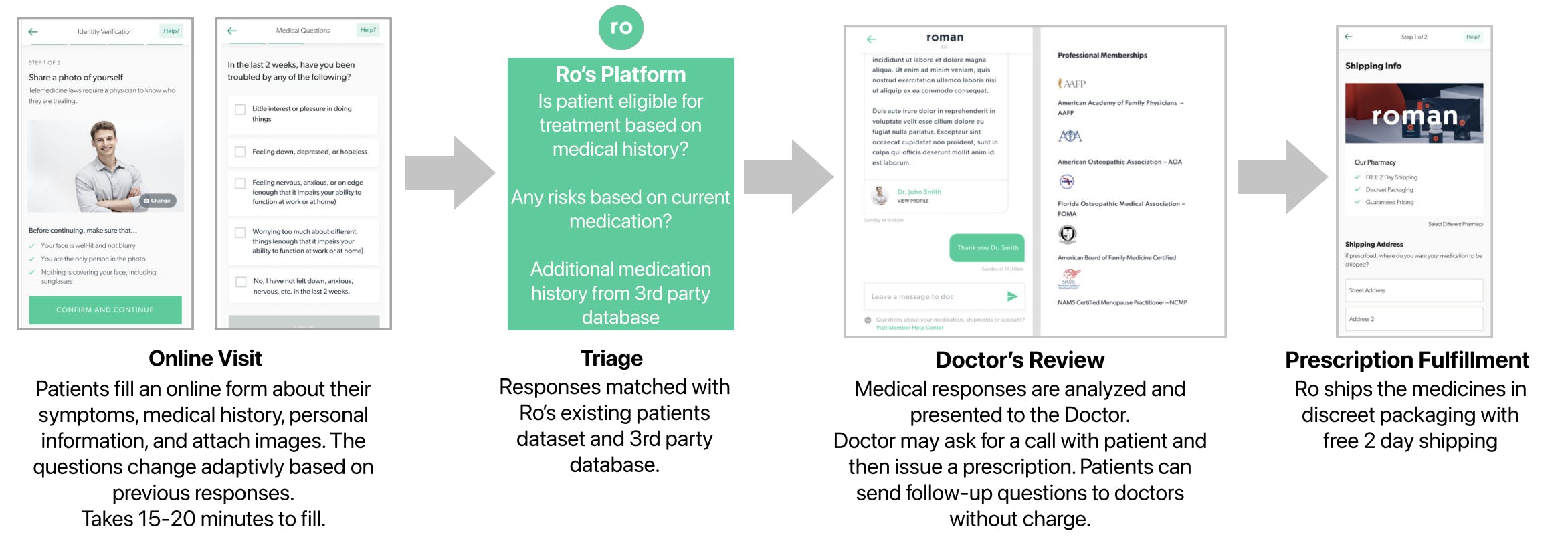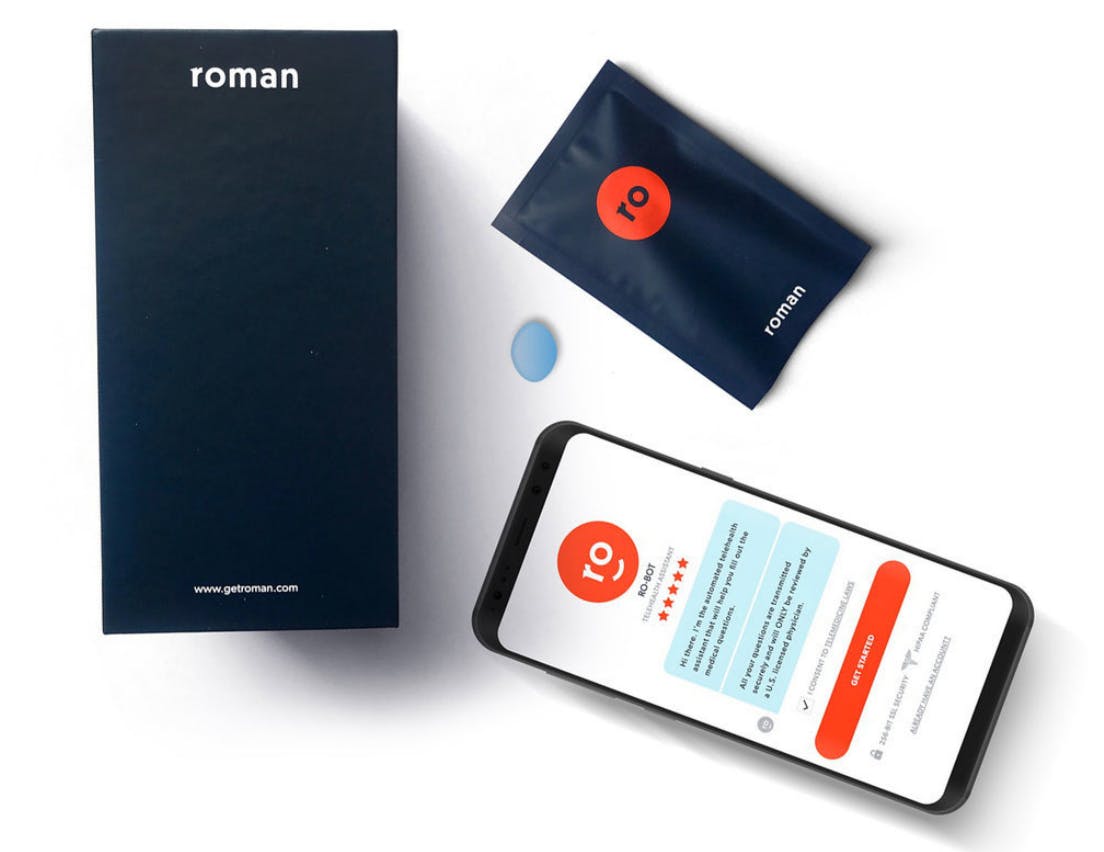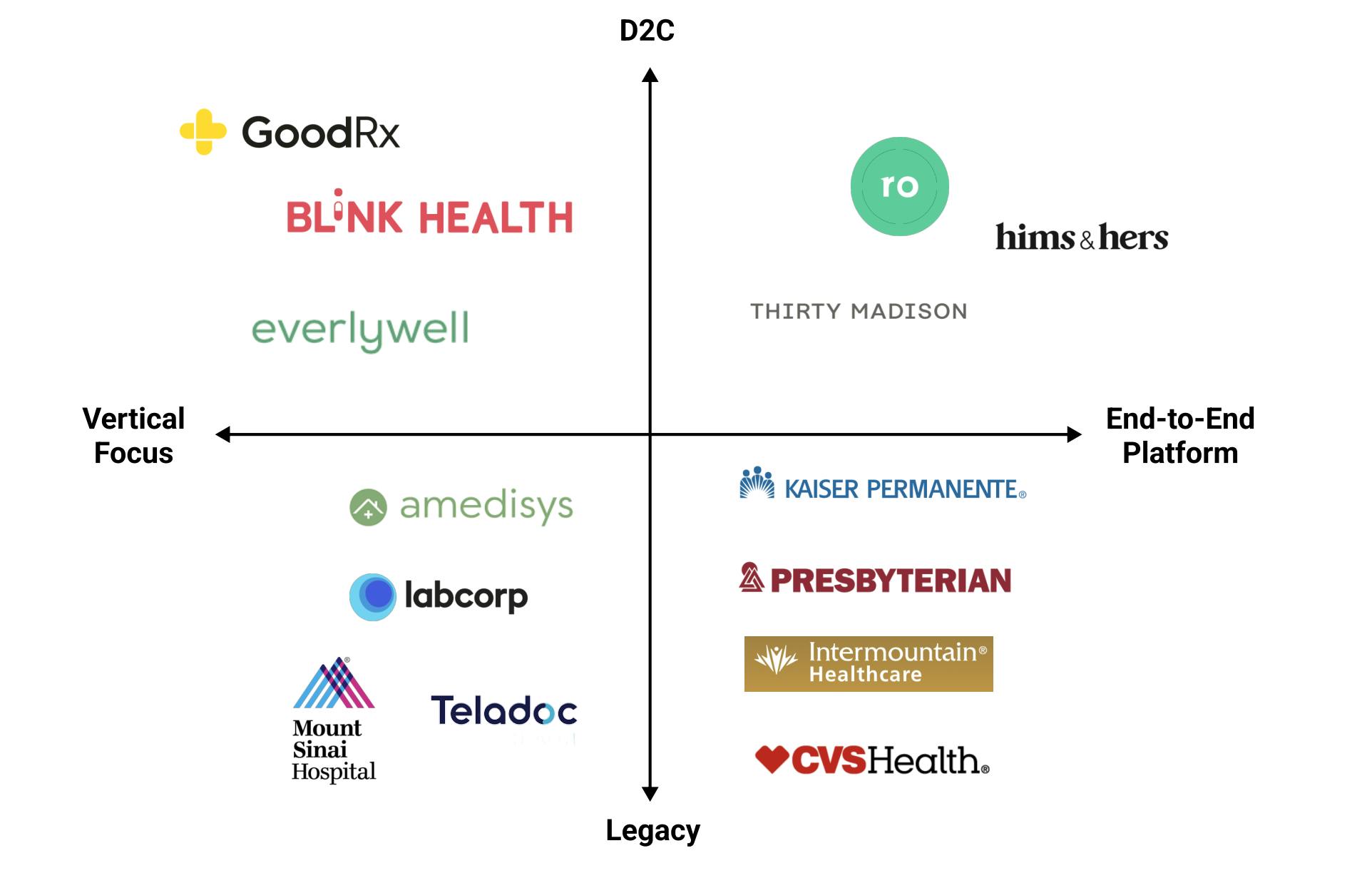
Revenue
$598.00M
2024
Valuation
$7.00B
2025
Funding
$1.00B
2025
Growth Rate (y/y)
66%
2025
Revenue
Sacra estimates that Ro hit $598M in annualized revenue in 2024, up 66% year-over-year from $360M in 2023.
This reacceleration was driven overwhelmingly by the launch and scale-up of Ro Body, the company’s GLP-1–centered obesity management business, which became Ro’s primary growth engine by late 2023.
Historically, Ro’s revenue was dominated by Roman, its erectile dysfunction and men’s health franchise, which accounted for ~60% of revenue in 2021. As competition intensified and generic pricing compressed margins in ED, Roman’s relative contribution declined even as it remained a large, stable cash generator. By EoY 2024, we estimate ED/sexual health represented roughly ⅓ of total revenue.
In contrast, GLP-1 obesity management scaled from a negligible share (~3%) of revenue in 2021 to ~40% by EoY 2024, contributing the majority of incremental growth. Consumer credit card data shows total Ro sales roughly 2x’ing between January 2023 and August 2024, while GLP-1–related sales grew ~3x over the same period. We estimate Ro generated ~$370M in GLP-1 revenue in 2024, supported by a combination of monthly care subscriptions (~$145), pharmacy economics, and high average order values relative to legacy categories.
Ro’s remaining ~25% of revenue comes from a diversified set of non-obesity, non-ED lines — including dermatology, hair loss, fertility, and at-home diagnostics — which monetize the same vertically integrated telehealth, lab, and pharmacy infrastructure at lower ARPU but higher stability. These categories provide a recurring revenue base that both smooths volatility in GLP-1 pricing and serves as cross-sell surface area for the millions of users entering through Ro Body.
Valuation & Funding
Ro’s most recent priced primary round was in February 2022, when it raised $150M in a round led by ShawSpring and participated in by existing backers including General Catalyst, FirstMark, and TQ. That round valued Ro at a $7B valuation, up from $5B in March 2021, and brought total funding to $1.0B in primary capital.
Product

How Ro works
Ro started life in 2017 as Roman, with a focused insight about how telehealth adoption actually begins. The most receptive users are not people casually experimenting with virtual care, but patients dealing with high-intent, high-stigma conditions where discretion, speed, and convenience matter as much as clinical quality.
Erectile dysfunction, hair loss, herpes, and similar categories created a wedge where a direct-to-consumer experience felt strictly better than traditional care rather than a second-best substitute.
That initial wedge allowed Ro to reframe the doctor–patient interaction itself. Instead of patients searching for a doctor, waiting for an appointment, and compressing their concerns into a short in-office visit, Ro inverted the flow.
Patients begin with a structured online intake, clinicians review asynchronously, and care is delivered through a combination of messaging, phone, and video when necessary. Follow-ups are unlimited and ongoing, which makes the relationship feel continuous rather than transactional.
Over time, Ro’s product has shifted away from being defined by the telehealth visit and toward being defined by the care pathway.
The real unit of value is not a single consultation, but a repeatable clinical loop that includes intake, eligibility checks, prescribing, fulfillment, monitoring, and renewal. This approach works especially well for medication-driven, protocol-heavy conditions where outcomes improve with consistent follow-up rather than episodic care.
That logic culminated in the formalization of ro.OS, which packages what Ro had been building internally into a unified operating layer across patients, providers, pharmacy, and labs.
The ambition is to make longitudinal care operationally cheap and reliable enough to scale, particularly for conditions that require ongoing medication management and testing rather than one-off diagnoses. In this framing, video visits are incidental. The product is the system that keeps care moving without friction across months or years.

Roman’s aesthetic D2C packaging
Competition

Direct-to-consumer telehealth clinics
Ro’s most direct competitors are other D2C telehealth companies that pair performance marketing with condition-specific care pathways. Companies like Hims & Hers, Thirty Madison, and LifeMD follow a similar playbook: start with a narrow, high-intent category and expand horizontally into adjacent conditions.
In this segment, differentiation based purely on convenience or price is fragile. Generic medications are undifferentiated, marketing costs rise quickly, and patients can switch providers with minimal friction.
Ro’s competitive defense is not meaningfully better telehealth, but deeper workflow integration that supports more complex, longer-duration care journeys involving labs, follow-ups, and insurance navigation.
Platform telehealth incumbents
Large telehealth platforms such as Teladoc and Amwell operate primarily through employers, health plans, and health systems.
Historically, Ro avoided direct overlap by focusing on direct-pay patients, but that separation is eroding as Ro expands into chronic conditions where reimbursement, documentation, and outcomes tracking matter.
These incumbents benefit from distribution scale and embedded relationships, while Ro benefits from consumer brand strength and faster iteration.
The competitive question is whether Ro can maintain D2C velocity while building the operational rigor required to sell into payer and employer environments without losing its product simplicity.
Retail healthcare and pharmacy gravity
An increasingly important competitive force comes from retail healthcare and pharmacy-adjacent models that can bundle basic telehealth into broader consumer ecosystems.
As pharmacy chains, retailers, and manufacturers themselves expand access channels, telehealth risks becoming a commodity feature.
Ro’s response has been to integrate directly into manufacturer-supported distribution programs rather than competing against them.
By positioning itself as the experience and care orchestration layer on top of these channels, Ro aims to retain ownership of the patient relationship even as the underlying supply landscape shifts.
TAM Expansion
Ro’s entry into other parts of the healthcare stack through acquiring new products to become vertically integrated is the key to their future growth.
As the largest player in D2C telemedicine, Ro’s brand allows it to attract patients at lower CAC anywhere in the stack and then cross sell and upsell other services, allowing them to grow LTV beyond just selling generics.
Obesity as a structural market unlock
Obesity represents Ro’s most meaningful TAM expansion because it changes both the size of the market and the nature of the buyer.
Treating obesity as a chronic disease pulls Ro into ongoing care, higher per-patient revenue, and greater interaction with insurers. This expands the addressable market far beyond convenience-driven telehealth and into core healthcare spend.
If Ro can demonstrate durable outcomes and operational efficiency in obesity care, the category becomes a template for expanding into other chronic conditions where medication, monitoring, and adherence drive long-term value.
Diagnostics and at-home care as infrastructure
Ro’s acquisitions in diagnostics, fertility testing, and in-home care delivery point toward a broader strategy of pulling more of the healthcare stack into the home.
These assets are not standalone growth bets so much as infrastructure that enables more complex care pathways without relying on external providers.
Owning diagnostics and sample collection allows Ro to close the loop between prescribing and monitoring, which is essential for scaling longitudinal care. Over time, this infrastructure can be reused across multiple conditions, increasing leverage as Ro adds new programs.
Employer and payer adjacency
Longer term, Ro has the option to expand into employer and payer partnerships by positioning itself as the front door for specific conditions rather than a generalist telehealth provider.
This would allow Ro to access larger, more stable budgets, but it requires defensible outcomes data, deeper integrations, and a fundamentally different go-to-market motion.
ro.OS is the technical foundation for this expansion, but success depends on whether Ro can translate internal platform strength into externally credible value for payers and employers.
Risks
Bundling commoditization: Condition-focused D2C telehealth is increasingly easy to replicate, and bundling alone may not be enough to sustain differentiation. If patients view Ro’s offerings as interchangeable with cheaper alternatives, retention and lifetime value will suffer as acquisition costs rise.
GLP-1 supply and coverage volatility: Ro’s weight loss growth is exposed to drug availability, insurer coverage decisions, and regulatory changes around compounding. Sudden shifts in access or reimbursement could materially impact demand and unit economics.
Late-stage valuation pressure: Ro’s past valuation levels set high expectations for growth and eventual liquidity. If growth slows or margins compress, the gap between operational performance and valuation assumptions could constrain strategic flexibility and talent retention.
News
DISCLAIMERS
This report is for information purposes only and is not to be used or considered as an offer or the solicitation of an offer to sell or to buy or subscribe for securities or other financial instruments. Nothing in this report constitutes investment, legal, accounting or tax advice or a representation that any investment or strategy is suitable or appropriate to your individual circumstances or otherwise constitutes a personal trade recommendation to you.
This research report has been prepared solely by Sacra and should not be considered a product of any person or entity that makes such report available, if any.
Information and opinions presented in the sections of the report were obtained or derived from sources Sacra believes are reliable, but Sacra makes no representation as to their accuracy or completeness. Past performance should not be taken as an indication or guarantee of future performance, and no representation or warranty, express or implied, is made regarding future performance. Information, opinions and estimates contained in this report reflect a determination at its original date of publication by Sacra and are subject to change without notice.
Sacra accepts no liability for loss arising from the use of the material presented in this report, except that this exclusion of liability does not apply to the extent that liability arises under specific statutes or regulations applicable to Sacra. Sacra may have issued, and may in the future issue, other reports that are inconsistent with, and reach different conclusions from, the information presented in this report. Those reports reflect different assumptions, views and analytical methods of the analysts who prepared them and Sacra is under no obligation to ensure that such other reports are brought to the attention of any recipient of this report.
All rights reserved. All material presented in this report, unless specifically indicated otherwise is under copyright to Sacra. Sacra reserves any and all intellectual property rights in the report. All trademarks, service marks and logos used in this report are trademarks or service marks or registered trademarks or service marks of Sacra. Any modification, copying, displaying, distributing, transmitting, publishing, licensing, creating derivative works from, or selling any report is strictly prohibited. None of the material, nor its content, nor any copy of it, may be altered in any way, transmitted to, copied or distributed to any other party, without the prior express written permission of Sacra. Any unauthorized duplication, redistribution or disclosure of this report will result in prosecution.